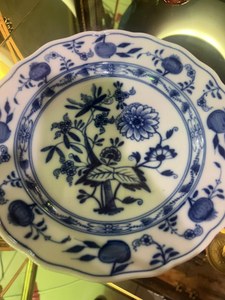In 1723, the director Johann Herold, introduced brilliant overglaze colours. His enamel paints are still the basis of ceramic paints today. The signature underglaze “Meissen Blue” was introduced by Friedrich August Kottig and the popular “Blue Onion” pattern has been in production for nearly three centuries.
Meissen became very popular for making bespoke table centrepieces and figurines, as well as small tea and coffee services. From the 1730s they started making armorial porcelain dinner services, mainly for King Augustus, before expanding to the rest Germany and abroad. Augustus’ granddaughter, Maria Amalia of Saxony, married Charles III of Spain and her dowry included 17 Meissen table services, inspiring the couple to start the Capodimonte porcelain factory in Naples.
While its products are expensive the high quality and artistic value make Meissen porcelain desirable by collectors and connoisseurs. At Ghorbany Benmore we have magnificent Meissen pieces in stock, from the early 1800s to the early 1900s.



